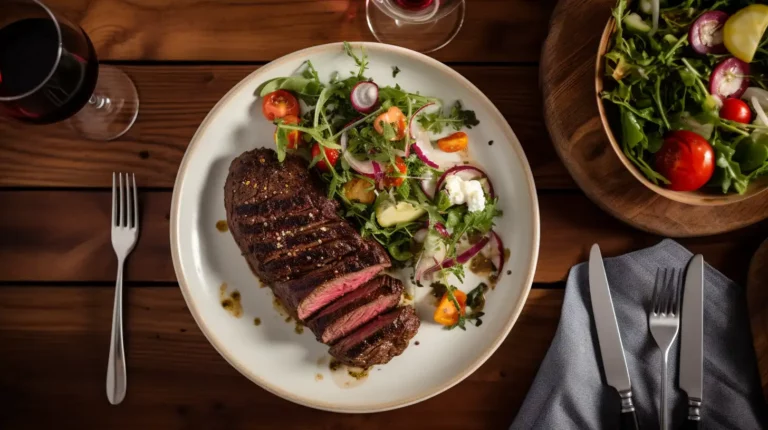A bag of chips, a slice of cake, and even the cheesiest of cheesy pizzas—food cravings can be a real struggle. So what do you do when they become too much to handle? Is it possible to learn how to stop food cravings from controlling your every move?
Because one minute, you’re cruising through the day, feeling wonderful about your lunch choice of a salad. And the next thing you know, you’re at the McDonald’s Drive-Thru, ordering a Big Mac, fries, and a vanilla milkshake.
Yes, it can be tough to resist those cravings. However, there are ways to conquer them.
It’s called WILDFIT, a program created by Eric Edmeades, trainer of Mindvalley’s Quest of the same name, to promote food freedom.
What causes food cravings?
We’re all familiar with that feeling—that salivating, lip-smacking yearning for a burger, a pizza, or a slice of cake. But what causes the irresistible urge that you just can’t seem to shake?
It could be due to several factors, like cultural influence, emotion, or hormones.
Even science has backed this up. For example, when you eat something sweet or fatty, your body releases dopamine, the “feel-good” neurotransmitter. That tells your brain, “This donut is fantastic,” and it reinforces your desire to want to eat that food again.
What’s more, stress and sleep deprivation have also been found to disrupt your body’s hunger signals. And that can trigger cravings, which can ultimately lead to weight gain.
That’s not all: The types of food you crave might be a clue to what your body might be lacking. For instance, one research study suggests that if you’re craving chocolate (as we all are), it may be an indication that you need more magnesium or antioxidants.
Cravings often represent a need, but many of us satisfy them with a want, according to Eric in Mindalley’s Conquer Your Cravings Challenge 2022 (available for replay for Members on the Mindvalley app).
So the next time you catch yourself reaching for that bag of chips, freeze!…and then consider what your body might really be asking for.
How to mindfully manage food cravings
Cutting out all the “goodies” the food industry feeds us is far from easy. So one way to learn how to stop food cravings naturally is through mindfulness.
Many of us have been taught to choose to eat foods that we enjoy the most, not necessarily the foods that we need the most.
— Eric Edmeades, trainer of Mindvalley’s WILDFIT Quest
Here are three things you can do:
1. Manage your body’s needs
One of the things that the WILDFIT Quest teaches you is that “diet” doesn’t mean a “temporary alteration of your life for short-term gain.” What it really means is “way of life.”
And this “way of life” is seasonal, meaning that certain times of the year call for certain kinds of foods to be eaten. For example, in the winter, it’s sustenance in the form of fat.
With that being said, there are core year-round needs that keep your body functional, however. Here are some (in no particular order):
- Air,
- Water,
- Food,
- Sunlight, and
- Sleep.
So when you fulfill these core needs, you may just find that your cravings greatly reduce.
What you can do: “What if, instead of being reactive to our unmet needs, we decide to be proactive and seek to meet the needs?” Eric asks.
So when you notice that “I want that [insert unhealthy food here]” craving coming up, you fulfill your core needs: go out and get some air and sun, drink a glass of water, eat a nutritious meal, or take a nap. See what happens to your cravings then.
2. Slow down and savor each bite
It can be tempting to wolf down everything at a meal. After all, we are living in a time where food is abundant and there’s not some kind of predator, like a vulture, waiting to grab your meal (or—the horror!—you).
So it might be helpful to slow your roll. In fact, one study found that the participants who chewed about 40 times before swallowing ate less. This method allows you to tune into your hunger and fullness cues.
Additionally, pay attention to the flavors and textures of your food. When your attention is on the experience, it can reduce the urge to chomp, chomp, chomp down those unhealthy treats.
What you can do: Being mindful of food is all about intuitive eating—being conscious and intentional about what you eat. And this can help you learn to recognize and respond to your cravings in a more healthy way.
3. Identify your triggers
Emotional hunger is no joke because, let’s face it, food can sure be comforting, especially when you’re stressed or overwhelmed. But, as mentioned, that doesn’t mean it’s necessarily what your body needs.
“It’s not the food that makes you feel better,” says Eric. “It’s the decision to eat it—it’s the rebellion, it’s the decision, [and] it’s the reward.”
When you’re aware of your triggers, you can go for a walk or practice deep breathing. These alternative ways to cope can really help you deal with how to stop food cravings when you’re not hungry.
What you can do: Being mindful means taking the time to listen to your body and being in sync with it. So ask yourself the following questions:
- What need is triggering your hunger? Physical? Emotional? Expectation? Fatigue?
- What does it feel like in your body? Really focus and describe in detail to yourself the type of physical sensations you experience.
- What is your mind saying? What are the tricks it’s using to convince you to indulge?
The more you’re aware of your body’s cues, the more you’ll be able to get a hold of your cravings and eat the right foods for your moods.

How to stop junk food cravings
A bag of chips, a candy bar, a pint of ice cream, a box of donuts, fast food… There’s no denying that junk food can be hard to resist.
According to the Centers for Disease Control and Prevention (CDC), more than 70% of adults in the United States are overweight or obese. So that begs the question: Why are they so addictive in the first place?
Several reasons, according to Eric. Here’s a closer look at what they are:
- It stimulates your appetite. These highly processed foods have a high content of sugar, salt, and unhealthy fats, and that’s going to “make you hungry, and you’re going to eat more food,” as he explains.
- It creates a cycle of cravings. The more junk food you eat, the more dopamine gets released, and the more you want that snack again. It’s a vicious cycle, no doubt.
What’s more, junk food has been known to be linked to various health issues. One example is attention deficit hyperactivity disorder (ADHD)—children who choose processed foods are more likely to have symptoms of the disorder than those who eat healthier foods.
And as Eric adds, the addictive ingredients—sugar, salt, and unhealthy fats—are often hidden, so you don’t even know you’re eating them. And then you wonder why you’re craving it all the time.
Stop the junk
So how can you stop getting the insane urge to reach for that bag of chips or order from your favorite fast food joint? Making the switch from those to healthier alternatives is absolutely easier said than done.
However, where there’s a will, there’s definitely a way. And that way is through these three bits of wisdom, taken from Mindvalley’s WILDFIT Quest.
1. Understand your hungers
You probably know why you eat—the obvious reasons are for sustenance and to appease your hunger. But have you ever wondered why you eat what you eat?
In Eric’s research, he found that there are six types of hunger that influence our food decisions:
- Thirst
- Emotions
- Variety
- Low blood sugar
- The desire to eat
- Nutritional
“Once you begin to understand why you make your food decisions the way you do,” says Eric, “you begin to take a step toward food freedom.”
2. Get in your core needs
As mentioned, your core needs help to keep your well-being in tip-top shape. Here are the eight to be aware of:
- Air. Clean air is one thing; knowing how to breathe properly is another. In the WILDFIT Quest, Eric suggests the 5-5-5: Inhale for five counts, hold for five counts, and exhale for five counts.
- Water. It’s been drilled in our heads to drink at least six to eight glasses of water a day. Not Coca-cola. Not coffee. Good ol’ fashion water.
- Sleep. Lack of it can affect your hunger-regulating hormones. So when you know how to get deep, quality sleep, you’ll also know how to stop food cravings, especially at night.
- Energy. Your main fuel sources for your body are fat, carbs, and proteins. And these can be found in immunity-boosting foods.
- Movement. This helps with lymph flow, which helps get rid of the toxins in your body. So get in your steps, do some yoga, or whatever it is that gets you moving.
- Sunlight. Most people get vitamin D from fortified milk. The thing with that is, dairy can be bad for you. So the best source of vitamin D, specifically for humans, is the sun.
- Non-energy nutrients. Your body needs fiber, vitamins, and minerals that come from seasonal foods. As Eric says, “Fruits and veggies don’t fight disease; their absence causes it.”
- Touch. Did you know that we need four hugs a day for survival, eight hugs a day for maintenance, and 12 hugs a day for growth? That’s according to family therapist Virginia Satir. But she’s not wrong; science has shown that touch can be incredibly therapeutic.
3. Evolve your relationship with food
“Eat a balanced diet”—that’s often the advice we get, yet we don’t really follow it. In fact, it’s nothing close to the common diet mentality.
When you nourish your body with fresh fruits and vegetables, healthy fats, and lean proteins, your body gets the nutrients it needs. And as a result, you don’t have to rely on highly processed junk as your food source.
This is what “food freedom” is all about.
Freedom is not eating whatever you want whenever you want but also not eating what you don’t want when you don’t want.
— Eric Edmeades, trainer of Mindvalley’s WILDFIT Quest
It’s about eating for the seasons. It’s about taking a mindful approach to nutrition. And, most importantly, it’s about working as one with your body.
“The more closely a species adheres to their natural evolved diet,” says Eric, “the healthier that species will be.”
Conquer your cravings
Learning how to stop food cravings can feel like pushing a boulder up a mountain. But when it comes down to it, it’s mind over munchies.
It’s not really about changing your diet or going cold turkey. It’s about learning how to approach what you eat and how you eat in a mindful way.
And you can do so on Mindvalley’s WILDFIT Masterclass. With guidance from Eric Edmeades, you’ll learn how to break free from the bad cycle of cravings and adopt the habits to live the actual definition of “diet.”
Now, put that bag of chips down. And get to WILDFIT-ing instead.
Welcome in.









